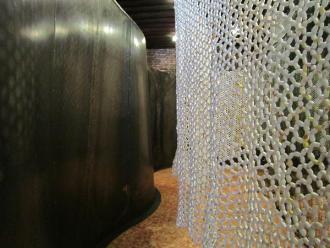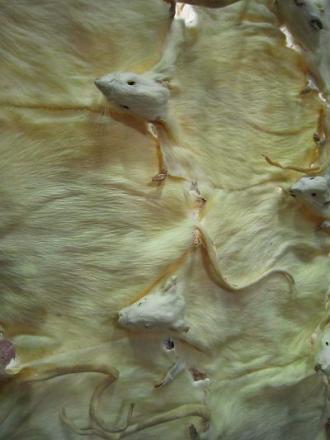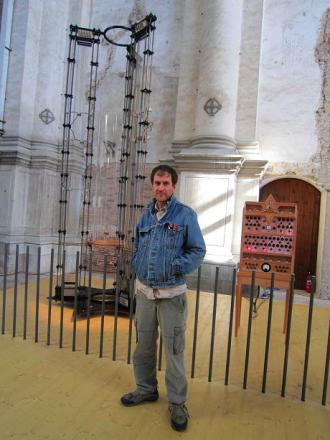The 55th International Art Exhibition – La Biennale di Venezia has opened to the press yesterday, 29 May. But the curious passersby had already glimpsed artworks being readied around the city.
ELPIDA HADZI-VASILEVA (MACEDONIA)
Our first meeting was with Elpida Hadzi-Vasileva, about her work Silentio Pathologia. Working out of England, the artist represents her home country of Macedonia. This is only the fourth Biennale for a post-Jugoslav Macedonia. The viewer is offered a maze-like path that begins with a solid shell of 3-meter high steel sheets, passes through curtains made up of thousands of silkworm cocoons, and curves around an expanse of tanned and sewn-together albino rat skins, before ending with delicate skeins of black silk surrounding two cages housing some (live, black, tame) Venetian rats.

Elpida Hadzi-Vasileva, Silentio Pathologia. detail. Photo: Marjorie Och.
The contrasts of hard and soft, black and white, gauze-like transparency and opacity set up the final dichotomy of dead and alive. Here the artist makes the silent pathology of history – the bubonic plague, introduced to Venice in the fourteenth century, carried there by rats on ships engaged in the Silk Route trade – speak about the rapid spread of disease today, and the likely creation of new viruses tomorrow. A powerful and poetic work that sets a high bar for installations that attempt to be both site specific and universal. We shall see tomorrow if the works in the Giardini Pubblici rise to the challenge.

Elpida Hadzi-Vasileva, Silentio Pathologia. detail. Photo: Marjorie Och.
ARIEL GUZIK (MEXICO)
An interesting comparison can be made with Mexico’s Ariel Guzik. He has built a four-meter tall sound machine called Cordiox that turns environmental changes into music.
Temperature, humidity, the presence of people in the room – all of these create vibrations in a special 180 x 45 cm hollow quartz cylinder only 5mm thick. Adjacent strings (like those of a piano) vibrate in sympathy with the quartz, and create sound. Although Hadzi-Vasileva’s work is largely handcrafted, it deals with a substantive, contemporary concern -- the spread of disease. Far more high-tech, Guzik’s work focuses rather on ethereal ideas of entropy and natural harmonies (“the music of the spheres”).
For all their differences, both works appeal to multiple senses, and both take site-specificity to new levels. Silentio Pathologia is housed in the former Scuola dei Laneri (the wool workers’ confraternity). Like silk, wool was a commodity whose trade routes may have been implicated in the spread of the plague. Guzik’s Cordiox is sited at the church of San Lorenzo, whose acoustics have been celebrated for centuries by such musical luminaries as Antonio Vivaldi. Kudos to the curators, Ana Frangovska (Macedonia) and Itala Schmelz (Mexico), for their sensitivity in selecting sites that strengthen the experience of the artwork.

Ariel Guzik and his Cordiox sound machine. 2013. Photo: Marjorie Och.
Preston Thayer and Marjorie Och reporting from Venice.